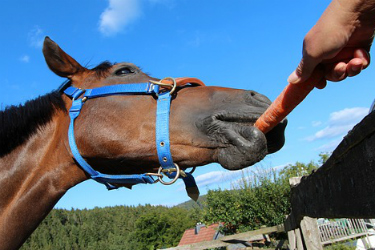Determining Equine Nutritional Needs: Factors to Consider

A good feeding tip to pass on to clients who are new horse owners should be that not all horses need to be fed the same. In order to determine the optimal dietary needs for the animal, several factors that relate directly to the individual horse need to first be considered by both the veterinarian and the horse owner.
Body Condition Scoring
Body condition scoring (BCS) helps to provide an objective evaluation of the amount of stored fat on a horse, which can help to determine its dietary needs. Clients can assist their veterinarian to determine the correct body condition score of their individual animal. Using this information will help an owner establish a program of feeding that will neither overfeed nor underfeed the animal.
The BCS works on categories that range from poor body condition to very fat body condition and can help to identify whether the horse may be an easy-keeper or a hard-keeper. The assessments are based on the following areas of the body:
- Neck
- Withers
- Back and loin
- Ribs
- Hind quarters
Weight
Determining the weight of a horse is useful for many reasons:
- Provides an estimation of the amount of feed needed
- Verifies if the current amount of feed given is adequate
- When performed regularly, offers a picture that could indicate a change in the animal’s health status
Methods to determine weight:
- Walk-on scale
- Weight tapes
- Work by taking girth measurements
- Not accurate for late gestation pregnant mares
- Will not indicate small changes, but can give a good estimate if proper procedures are followed
Production Level
To a large extent, a horse’s life stage determines its nutrient needs. For example:
- Idle animals
- Animals that are not used for hard work or production are capable of maintaining their body’s needs with good quality grass or hay
- In instances where they require extra energy, the need could be met by providing extra hay rations or a type of concentrated energy source
- Broodmares
- A broodmare in good body condition can be fed in a manner similar to a mature animal, with good quality grass or hay
- After foaling, to provide for lactation, the energy, protein, and minerals needs are higher and can be met with a type of concentrated energy source
- Performance
- These horses require grains for energy needs, but do well with at least 50% good quality roughage
- Older animals
- The nutritional requirements of an older animal may need to be modified as their body changes; for example some may develop:
- Age-developed mouth problems, such as:
- Excessively worn or missing teeth
- These issues may require food to be ground or pelleted
- Age-developed health issues, such as:
- Impaired digestive systems
- Kidney or liver problems
- Pituitary tumors that cause loss of weight
- These animals may require a different nutritional feeding regimen
Environment
The environment plays a big part in a horse’s nutritional needs.
- Housing
- Horses that live outside all the time may require a different type of feed ratio than those animals kept in a stable
- Climate
- Feeding needs change depending upon the temperature
- The following details need to be considered for animals living in hot climates::
- Weight of animal
- Overweight horses have more difficulty keeping their body temperature down
- Water
- Drinking needs can increase by up to four times
- Forage
- Less need for forage, specifically legumes as they create additional unwanted heat during digestion
- Colder climates also have points to consider:
- The coat of a horse is important to its healthy survival in cold weather climates
- Horses previously kept in warm barns or ones who have been blanketed will not have a winter coat
- Animals who have moved in from warmer climates will take longer to grow a long-hair coat
- Body fat
- The body fat provides insulation and also energy for the horse to generate heat
- Animals in poor body condition will have increased nutritional energy needs
Before deciding upon the feed product for their animal, clients need to consult with their veterinarian to help determine the type of nutritional program right for their individual horse.
Want to learn more about equine related animal health issues? Contact your Covetrus representative today at 855.724.3461!
Information gathered from:
Horse Nutrition
Bulletin 762
The Ohio State University Extension
Copyright 2000
Need Regulatory Assistance
If you need help with regulatory or licensing issues, we're happy to help. We have a wide variety of resources to help you when issues arise.

Careers
Are you looking for a place to let your talents shine? At Covetrus, we help our practitioner customers better serve their patients and take pride in providing the best customer experience possible. Search our open positions to see our available opportunities.
Newsletter
Stay current with what’s going on with Covetrus, subscribe to receive our newsletter and email communications. Subscribers will receive the latest information in practice management, sales and marketing, animal health, and more.


Leave a comment